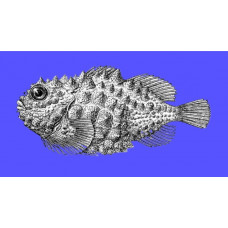Latin name
Eumicrotremus spinosus
Other name
Cyclopterus spinosus, lethotremus armouri
Identification
The Atlantic spiny lumpsucker has a bloated anterior body that is completely covered with regular rows of large, conical tubercles. The posterior part of its body is compressed from the sides, and the tubercles become shallower. There are four rows of tubercles in the interorbital space. The two inner rows of these tubercles increase in size toward the rear and form a dorsal row of tubercles. The bases of these tubercles are in contact with the base of the first dorsal fin. Between the dorsal fins, there is usually one pair of cusps. Small tubercles cover the chin. Tendril-shaped tubular appendages are present on the chin. There are 13-14 pores in the lateral line. The suction disk is large. The anal opening is separated from the posterior margin by a large gap much larger than the diameter of the eye. The skin is not smooth, but has jagged folds. Similar skin folds are usually well-developed on the underside of the head. Age variability in body armament is quite characteristic. In fry that are 10-12 mm long, the body is naked. At a length of 13-15 mm, small spines appear on the upper side of the head. At a length of about 20 mm, these spines become 2-4 spines that spread throughout the body. In larger specimens (30–35 mm), the spines transform into conical tubercles that are spiny and arranged in rows on the shortened body. Later, these tubercles enlarge significantly, touching at their bases.
Features of fish fins
These fish have small tubercles covering the base of their pectoral fins and usually at the tips of the dorsal fin rays. The dorsal fin is not covered with thick skin, and its rays are clearly distinguishable.
Fish colouring
This species' coloration can vary, typically ranging from brown to dull orange or red. Young specimens (up to 20 mm) have an olive body with five unpigmented spots at the base of the unpaired fins and light stripes on the head. Adult coloration is monotonous and darker from above; the bases of the tubercles may be outlined with a dark ring.
Distribution
This species inhabits the Arctic and the coasts of the North Atlantic. It is found in the Barents Sea, Svalbard, Franz Josef Land, Greenland, Iceland, Norway, Hudson Bay, and the Canadian Arctic. It has been reported as far south as Massachusetts. In Canada, they have been reported in Quebec, the Northwest Territories, and Nunavut.
Habitat
They are an offshore, bottom-dwelling species of fish. They are found at depths ranging from 30 to 400 meters (98 to 1,312 feet).
Size
This small fish has a maximum length of 13.2 cm (5.2 inches), though it is usually no more than 10 cm.
Behavior
Adults are most often found at depths of 60-70 to 150-200 meters, though they are occasionally found at greater depths (up to 237 meters off Svalbard and up to 300-400 meters off the western coast of Greenland). They are found at temperatures close to zero (from -1.8 to +2-3°) and in areas of high salinity (34-35 ‰). They prefer stony soils and, if they occur in soft sediments, it is usually with an admixture of stones or coquina.
Food and feeding habits
The Atlantic spiny lumpsucker feeds on crustaceans, small fish, and Oikopleura. Their diet has received little study. The only species found in the stomachs of specimens from Svalbard is Themisto libelula.
Reproduction
The fecundity of these fish has not been studied. Females approaching maturity are found in August and September. Females with mature eggs have been observed off the coast of Greenland in March. Mature ovarian eggs measure 3.2–4.5 mm in diameter. A clutch of eggs was found in late August on a hard substrate at a depth of 20-30 meters. Juveniles ranging from 10.5 to 25 mm in length are found offshore in the kelp and lithotamnia zone from mid-May to September. However, specimens ranging from 35 to 40 mm, as well as adults, live in deeper water.
Fishing
This species is not commercially important.
Relationship with a person
This is a type of fish that is harmless to humans.
| Classification | |
| Phylum | Chordata |
| Class | Actinopterygii |
| Squad | Perciformes |
| Family | Cyclopteridae |
| Genus | Eumicrotremus |
| Species | E. spinosus |
| Features | |
| Conservation status | Data Deficient |
| Habitat | Bottom |
| Life span, years | No information |
| Maximum body weight, kg | No information |
| Maximum length, cm | 13,2 |
| Sailing speed, m/s | No information |
| Threat to people | Edible |
| Way of eating | Predator |

